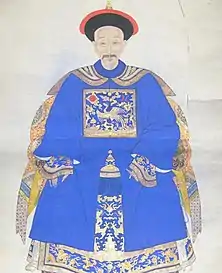Liu Yong (Qing dynasty)
Liu Yong (simplified Chinese: 刘墉; traditional Chinese: 劉墉; pinyin: Liú Yōng; 1719–1805) was a Chinese politician and calligrapher of the Qing dynasty.[1]
Liu Yong 劉墉 | |
|---|---|
 | |
| Grand Secretary of the Tiren Hall | |
| In office 1797–1805 | |
| Assistant Grand Secretary | |
| In office 1783–1789 | |
| Minister of Personnel | |
| In office 1792–1797 Serving with Jin Jian (until 1795), Baoning (since 1795) | |
| Preceded by | Sun Shiyi |
| Succeeded by | Shen Chu |
| In office 1783–1789 | |
| Preceded by | Cai Xin |
| Succeeded by | Peng Yuanrui |
| Minister of Rites | |
| In office 1791–1792 Serving with Changqing | |
| Preceded by | Ji Yun |
| Succeeded by | Ji Yun |
| Minister of Works | |
| In office 1782–1783 Serving with Cokto | |
| Preceded by | Luo Yuanhan |
| Succeeded by | Jin Jian |
| Viceroy of Zhili (acting) | |
| In office 1783–1783 | |
| Preceded by | Yuan Shoutong |
| Succeeded by | Liu E |
| Personal details | |
| Born | 1719 Shandong, Qing China |
| Died | 1805 (aged 85–86) Beijing, Qing China |
| Father | Liu Tongxun |
| Occupation | Politician, calligrapher |
Biography
Liu Yong was born in Shandong 1719 with courtesy name Chong Ru (崇如), pen name Shi An (石庵), nick name Prime Minister Hunchback Liu (宰相劉羅鍋) or Hunchback Liu (劉羅鍋/劉駝子).
He served in a number of high-level positions with a reputation for being incorruptible, including as the Minister of Rites and Minister of War,[1] and is regarded by some as the "most influential calligrapher of his time".[2]
References
- "Liu Yong — China culture". Archived from the original on 2009-08-12. Retrieved 2009-11-06.
- Stuart, Jan; Rawski, Evelyn Sakakida (2001). Worshiping the ancestors: Chinese commemorative portraits. Stanford University Press. p. 200. ISBN 0-8047-4263-4.
This article is issued from Wikipedia. The text is licensed under Creative Commons - Attribution - Sharealike. Additional terms may apply for the media files.